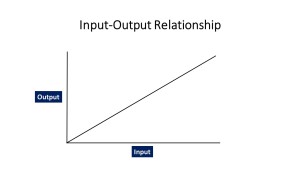A Critical Doer Generates Motion From “Why” More Than “What”
In the life of every organization, the environment changes over time. Changes in conditions that determine the rate at which production hums along leads to the question…how much can we do?
When faced with this situation, there are four general ways you can approach the problem: (1) do more with more (2) do less with less (3) do more with less (4) do more with the same.
When an organization is running at or near capacity and a demand signal increases, the easiest solution is to do more with more in a relationship as depicted in this figure.
Many times it takes additional resources to add capacity, but there are some traps in this decision that may not be obvious. The trap comes as we change our focus from the objective to symptoms of the environment. Sometimes we yield to a faulty assumption that capacity can only increase under the current conditions. This assumption can blind us to the opportunity to grow through innovation rather than spending, and it also can begin the slippery slope of conceding a competitive advantage through limited thinking.
In the same line of thinking, doing less with less sounds like an unthinkable option…but not if you use it to examine processes and stop doing non value-added activities while focusing on activity that is required for your product or service to reach a customer. This is the basis of Lean Thinking…a system of looking at processes to ensure your efforts are not wasted on nonproductive activity. Sometimes adversity gives us an opportunity for reflection that eventually helps us grow stronger…doing less with less may be the answer.
Doing more with less is an overused term that generally strikes a negative chord because it is miscommunicated and misunderstood. Doing more with less can be done from a task perspective and is commonly a function of technological advances. For example, in World War II it took over 900 B-17 bombers to achieve the same effect we get today from a single B-2 bomber thanks to stealth and precision munitions. Doing more with less can come off the rails however when we don’t properly value people as part of the resource equation. Technology brings efficiency but it does not innovate and build a future. Be very careful with this line of thinking that you don’t forego the future to address a short term problem.
Finally, an often overlooked way of thinking is doing more with the same. None of the ways of thinking I’ve listed thus far have to be reactive…but doing more with the same provides the greatest opportunity to be proactive. Here are some inherent strengths in this way of thinking: (1) preserves and fully utilizes human capital with full recognition that people are the engine of innovation (2) maintains a competitive advantage today through lower cost and frees up resources for growth (3) creating capacity through technology and process improvement ahead of demand provides a pathway to growth.
Critical doers, it’s important to recognize that conditions are constantly changing. If you’re not critically as while you’re doing about how to maintain the edge today while posturing for the future, you may be trusting your future to fate. Trust in yourself and apply the correct line of thinking to shape the environment rather than be shaped by it. It’s what a critical doer would…do!
Reminder: you can get automatic updates from The Critical Doer by using the subscription widget at the bottom of this post. You can also follow on Facebook, Twitter, and Google+. I also encourage you to let me know what you think of the posts or share a story of your own using the comments section or email me directly at [email protected].
